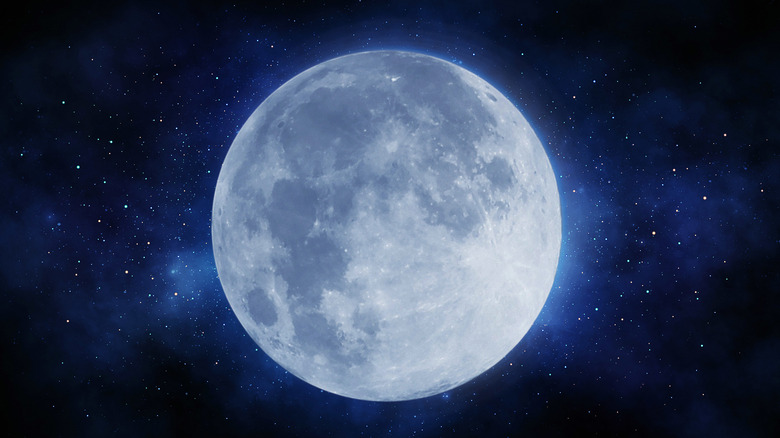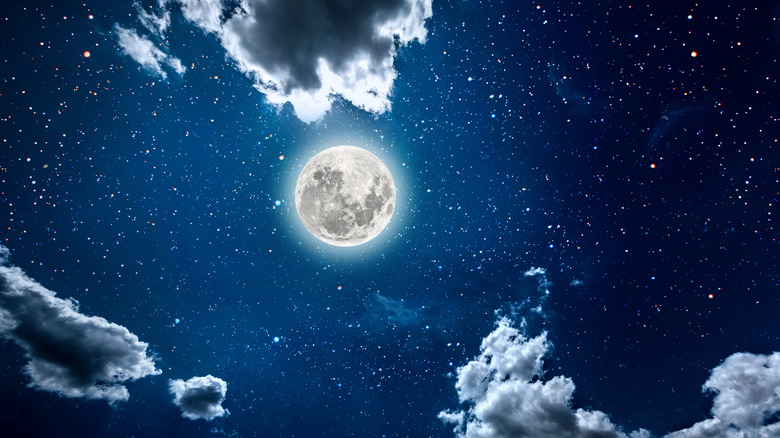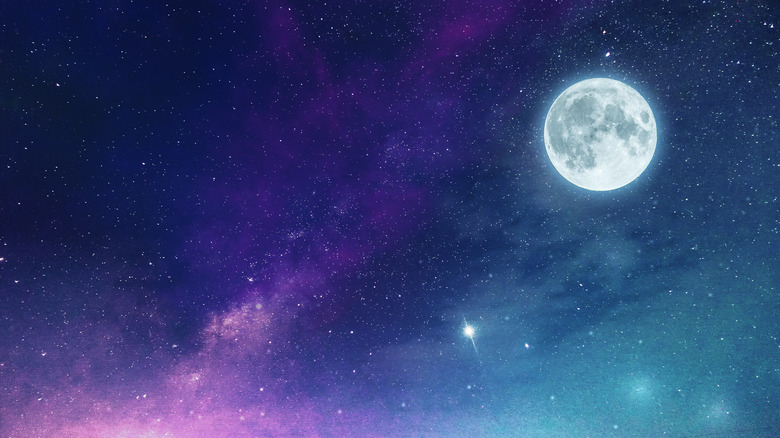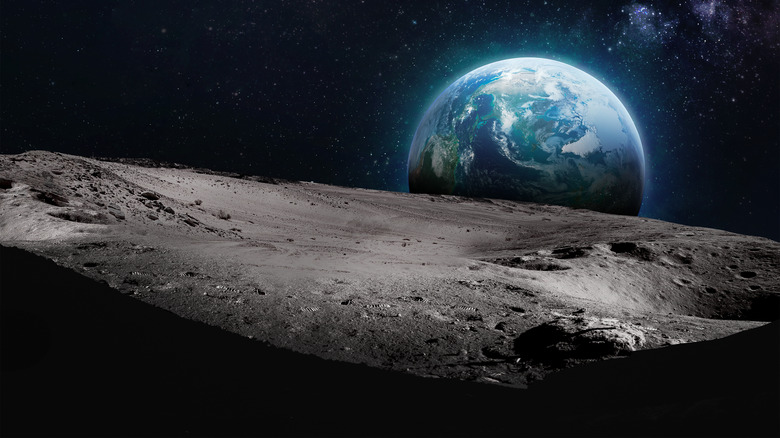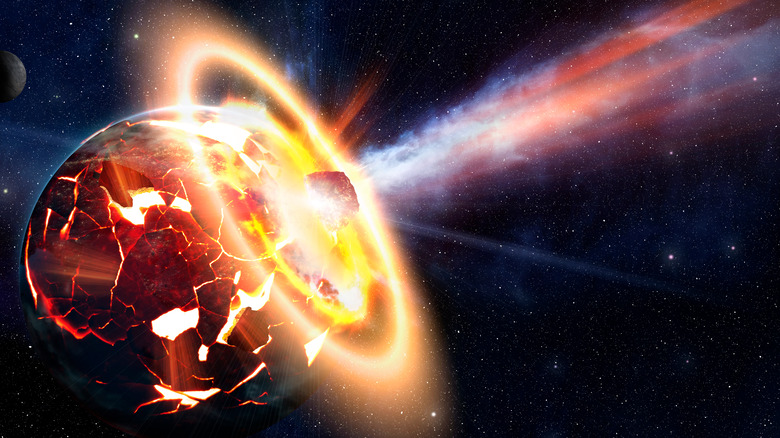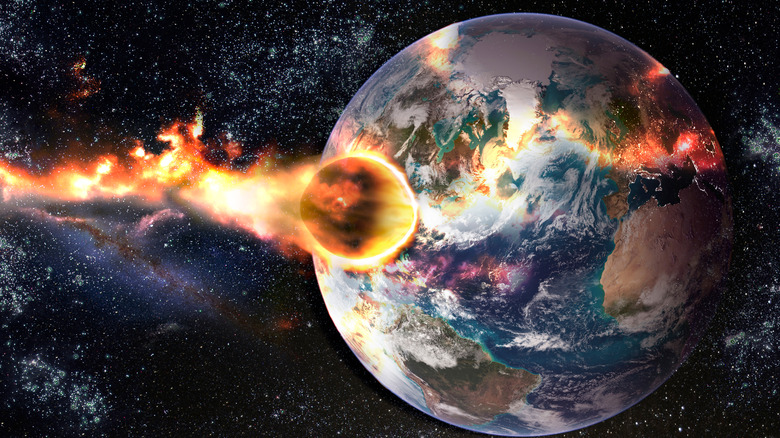The Biggest Theories About The Moon's Creation
The moon has been a part of human culture, mythology, and studies since well before recorded history, and it continues to fascinate us. Since our species has managed to put around a dozen people onto the lunar surface and return safely, it would be easy to assume that we know a lot about our nighttime companion, but the moon still provides many mysteries. In fact, we're not entirely sure how it got there.
According to Starchild, a theory of the moon's formation has to address three facts. The first is the moon's density, which is low, meaning that it doesn't have a heavy iron core as the Earth does. The second is the scarcity of volatile substances like water in moon rocks, suggesting that the lunar surface was "baked" longer than Earth's was. Finally, the moon has an identical relative abundance of oxygen isotopes as the Earth, meaning it was formed at the same distance from the sun as our home planet. Several very plausible theories have been put forth about the origins of the moon, but none has been completely satisfactory to the astronomical community.
The moon might have been stolen
One theory that technically doesn't explain how the moon was formed but rather how it got to where it was today is the capture theory (via Space). The idea is that the moon was formed somewhere else but got "stolen" by the Earth's gravitational pull and locked into orbit. One of the biggest points in favor of this theory is that it's happened before: The two moons of Mars, Phobos and Deimos, are most likely captured asteroids.
The biggest issue with the capture theory is the geological similarities between the Earth and the moon. Those identical oxygen isotopes strongly point to the moon coming from the same pool of material as our home planet, which doesn't explain how our natural satellite could be formed around, say, Venus. There's precedence to a planet's moons being picked out of the cosmos via gravitational pull, but the evidence for this theory is slim, and the evidence against foreboding.
The Earth might have spun the moon off
In the 19th century, George Darwin — son of evolution pioneer Charles Darwin — put forth the fission theory, which attempted to answer why the moon was so similar to the Earth (via Treehugger). The hypothesis states that in the early stages of Earth's formation, it was rotating fast enough to cause a chunk to spin off into space while still keeping it on a tight leash via our planet's gravity. The theory gained traction, with some stating that the Pacific Ocean would have housed the material that eventually became the moon.
This theory took a huge hit after the Apollo program, however. Analysis of moon rocks taken from these missions showed that their composition didn't match samples taken from the Pacific. The reason: the Pacific Ocean is actually younger than the moon. According to Space, most scientists never really thought it possible for the Earth to have spun fast enough to shoot off a moon-shaped blob, although it is possible for a natural nuclear explosion to have been the catalyst for ejection.
The moon could have developed alongside Earth
After the capture and fission theories were largely discounted, puzzled scientists began to consider what some call the sister hypothesis, which states the moon formed alongside the Earth. This formation could have been aided by material separated from the planet like the fission theory — if researchers could find a more reasonable explanation for how that separation came about (via Lumen).
The co-formation would have been around 4.5 billion years ago, as dust and gas were coalescing into our planet (via Space). This theory provides a good explanation for the similarities in oxygen isotopes, but it ran into problems as more information about the moon was uncovered. Things like the angular momentum of the Earth's relationship with the moon and, more damningly, the lack of a significant iron core in the moon mean the theory fell short. However, progress was made, and more credible theories arose to describe how a chunk of Earth became the ever-present orb in the night sky.
The giant impact theory is most popular today
The information and analysis gained from the Apollo missions sparked new debate and theories about the formation of the moon, and the ones that survive today come from the giant impact model (via the Natural History Museum). The theory states that in the early stages of Earth's creation, there were two planetary bodies: a proto-Earth, and Theia. Theia was made out of nearly identical materials as the early predecessor to Earth, and the two bodies collided and merged to form the planet we live on today. A smaller chunk split off during this collision, which formed the moon.
This would explain the similar material compositions in the moon and Earth while also doing a better job than the fission theory at explaining how a moon-sized blob could break off from our planet to form the glowing disk among the stars. However, it leaves some questions unanswered, like how the Earth and moon are chemically similar. Different models showed that the moon should look more like Theia than Earth, which led some to doubt the existence of Theia at all (via The Conversation). But if Theia was made out of the same materials as Earth, that question would be answered.
Variations on the impact theory are being made
Even today, scientists struggle to come up with a completely satisfactory theory. The giant impact model proposed in the 1970s gets more and more scrutinized with every passing year, and astronomers are still proposing new ideas that fit the growing knowledge on Earth and the moon (via Quantum Magazine).
The Theia-Earth collision could have struck with such force that both planets were instantly vaporized, jumbled together like a cosmic stew, then cooled off, with the outer remnants of the cloud of debris forming the moon and the center forming Earth. Perhaps there was more than one Theia — and once, more than one moon — as several smaller impacts formed "moonlets" that eventually merged into the moon we see today. Other theories again modify the fission theory and suggest an extremely rapidly spinning Earth was grazed by Theia, mixing the remnants together. It's still a massive mystery at the heart of astronomy, but it seems every decade, scientists get closer and closer to unlocking the truth.
